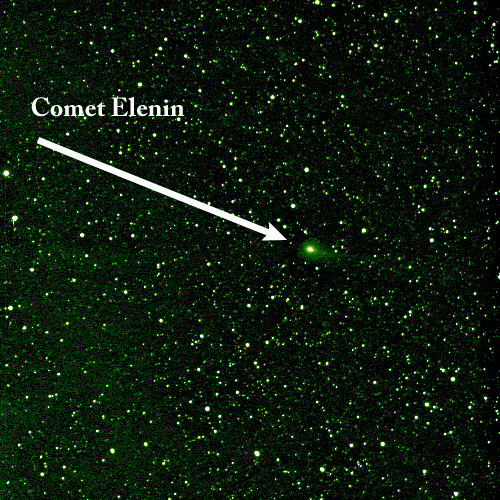
Comet Elenin as seen by HI1-B on Aug. 6, 2011.
As Comet Elenin passed to within just 7 million
kilometers of the STEREO (Behind) spacecraft, NASA rolled the spacecraft to
take a look at it (Aug. 1, 2011) with its wide angle HI-2 instrument. Though
the observation lasted only a little over an hour, the fuzzy looking comet can
be seen moving across a small portion of the sky. STEREO will be taking these
one-hour observations every day through August 12. The comet is seen by the
HI-2 telescope between August 1-5, and by the higher resolution HI-1 telescope
between August 6-12. From August 15 onward, the
comet enters the HI-1 telescope's nominal field of view, at which time we
should enjoy continuous viewing of the comet. Over time, we expect the comet
to be visible in the SOHO C3 coronagraph on September 23 for six days and
possibly STEREO's COR2 coronagraph as well between August 20 and September
1. The closest the comet will come to Earth is 0.23 AU (Astronomical Units),
or approximately 34-million kilometers, so it poses no threat to us. We will
attempt to keep this page updated with the latest observations.
Single frames showing the comet are available, together with the regular
synoptic images, as part of the
SECCHI image gallery.
We do expect the comet to appear to become significantly brighter over the next few days as it gets closer to the Sun-spacecraft line as a consequence of a process known as foward-scattering. STEREO-B, which is far from Earth, happens to see this "back-lighting" effect as a consequence of its location relative to the comet, and is not indicative of a sudden change in the comet itself.
Russian astronomer Leonid Elenin discovered the comet last December at International Scientific Optical Network's robotic observatory near Mayhill, New Mexico.
From Earth, presently the comet is a faint smudge of light in deep sky exposures. By late August comet Elenin could be visible to the naked eye as a dim "fuzzy star" with a tail.